CSO Generator—A Parsimonious Wastewater Quality Model for Combined Sewer Overflows
Abstract
1. Introduction
2. Materials and Methods
2.1. Case Study Area
2.2. Monitoring Campaign
2.2.1. Monitoring Locations
2.2.2. Monitored Variables
- (1)
- Rainfall on the catchment surface (mm/h).
- (2)
- Flow in the sewer system and at the overflow, which varies due to the diurnal wastewater production, parasitic water, and rainfall (L/s).
- (3)
- (4)
- Conductivity, a simple and reliable measurement that we found to be relatable with ammonia (µS/cm2).
- (5)
- Ammonia concentration (grab samples) (mg/L).
- (6)
- Turbidity, as a surrogate for suspended solids (mg/L).
- (7)
- Suspended solid concentration (grab samples) (mg/L).
2.2.3. Monitoring Devices and Storage
2.2.4. Data Preparation
2.2.5. Hydraulic Data
2.2.6. WWTP Data
2.3. Modeling Concept
2.3.1. General Approach
2.3.2. Dissolved Compounds
- Smoothed rainfall (mm/h), which accounts for the volume of water flowing into the sewer, and consequently, the target concentration within the sewer.
- Water level (m), which determines whether the system has returned to dry weather conditions.
- Flow (L/s).
- Parasitic flow, which is used to determine dry weather dilution (L/s).
- A dry weather concentration (mg/L) (used in cases of no parasitic water), which is determined by the average load and flow of the households. The load and flow can be determined from the average load of the WWTP.
- The dry weather level (m). Below this level, there is no runoff effect anymore of any rain into the sewer. This parameter is dependent on the amount of parasitic water in the system.
- A daily wastewater profile. A sinus profile characterized by an amplitude and a phase shift (radians). Some authors [25] suggest using a combination of two sinus functions with several parameters.
- The equation used for the incoming time-dependent dry weather concentration at each node in the sewer system is represented as y = C_dry × (1 + ap sin(t/2pi + bp)), where y is the concentration, C_dry denotes the average dry weather concentration (mg/L), and ap and bp represent the two fitting parameters for the sinusoidal function.
- A rain factor (h/mm): to determine how much dilution comes from 1 mm of rain by using the following equation: C = C_dry × (1/(1 + rain factor × rain)). This parameter is related to the size of the runoff surface.
- A rain-dependent time delay (2 parameters: time-lag DWA and time-lag RWA (d)). This determines the time between the start of the rain and the reaction on the incoming concentration.
- The logistic function (2 parameters: c_logDWA and c_logRWA (1/d)). Our model incorporates a function that accounts for the time delay between the incoming concentration of pollutants in the sewer and the concentration at a specific location. This function also enables a smooth transition from the original concentration to another through an exponential curve. The time-dependent concentration equation utilized for this purpose is as follows: y = 1/(1 + exp(−1 × (t − b)/c_log)). The parameter c_log, which influences the steepness of the transition, is dependent on the rain, the flow rate, and the level within the sewer system.
2.3.3. Suspended Solids
2.3.4. Model Calibration
- Firstly, we need to identify the pipe in the trunk sewer (LCSO) where we can assume that the pollutant concentrations at the CSO will be similar to the concentrations at the LCSO. When this LCSO is close to a pumping station, the incoming pipe to the pumping station was chosen as LCSO because during dry weather the levels are as high as during wet weather. Before making this assumption, it is important to check for any differences between overflow and carry-on concentrations. For the locations discussed in this paper, any discrepancies between concentrations at LCSO and at CSO locations were assumed as negligible due to the short distance between the CSO and the LCSO and the small size of the CSO chambers.
- Secondly, the dry weather and parasitic flow and daily dry weather profile at the LCSO location must be known. This can be either determined by a measuring campaign or by a full dynamic model.
- Finally, the daily average pollutant load at the LCSO location must be determined, either through measuring campaigns or by deducing it from WWTP daily average loads and related people equivalent. If these data are not available, general patterns or design values from a WWTP can be used.
- Determine the dry weather flow logistic function parameter for soluble compounds.
- Determine the full set of parameters for soluble compounds.
- Determine all additional parameters for suspended solids compounds.
3. Results
3.1. NH4+ Concentration
3.2. NH4+ Load
3.3. Conductivity
3.4. Suspended Solids
4. Discussion
5. Conclusions
Author Contributions
Funding
Data Availability Statement
Conflicts of Interest
References
- Rossman, L.A. Storm Water Management Model: User’s Manual, Version 5.0; United States Environmental Protection Agency: Cincinnati, OH, USA, 2005.
- Innovyze. InfoWorks Integrated Catchment Modeling (ICM), Version 8.5.5; Innovyze: San Francisco, CA, USA, 2018. [Google Scholar]
- DHI. MIKE+Collection System User Guide; DHI: Shenzhen, China, 2023. [Google Scholar]
- Vezzaro, L.; Grum, M. A Generalised Dynamic Overflow Risk Assessment (DORA) for Real Time Control of Urban Drainage Systems. J. Hydrol. 2014, 515, 292–303. [Google Scholar] [CrossRef]
- Koot, A.C.J. Behandeling van Afvalwater; 2e ongew. en uitgebr. dr.; Waltman: Delft, The Netherlands, 1982; ISBN 978-90-212-3076-4. [Google Scholar]
- Lee, J.H.; Bang, K.W. Characterization of Urban Stormwater Runoff. Water Res. 2000, 34, 1773–1780. [Google Scholar] [CrossRef]
- Kabbani, M.S. Using PCSWMM to Simulate First Flush and Assess Performance of Extended Dry Detention Ponds as Structural Stormwater BMPs in a Large Polluted Urban Watershed. Ph.D. Thesis, University of Iowa, Iowa City, IA, USA, 2015. [Google Scholar]
- Kang, J. Modeling First Flush and Particle Destabilization: Implications for Design and Operation of Stormwater BMPs; University of California: Los Angeles, CA, USA, 2005; Volume 174. [Google Scholar]
- Di Modugno, M.; Gioia, A.; Gorgoglione, A.; Iacobellis, V.; la Forgia, G.; Piccinni, A.; Ranieri, E. Build-Up/Wash-Off Monitoring and Assessment for Sustainable Management of First Flush in an Urban Area. Sustainability 2015, 7, 5050–5070. [Google Scholar] [CrossRef]
- Kim, L.-H.; Jeong, S.-M.; Ko, S.-O. Determination of First Flush Criteria Using Dynamic EMCs (Event Mean Concentrations) on Highway Stormwater Runoff. Water Sci. Technol. 2007, 55, 71–77. [Google Scholar] [CrossRef] [PubMed][Green Version]
- Leutnant, D.; Muschalla, D.; Uhl, M. Stormwater Pollutant Process Analysis with Long-Term Online Monitoring Data at Micro-Scale Sites. Water 2016, 8, 299. [Google Scholar] [CrossRef]
- Gamerith, V.; Muschalla, D.; Veit, J.; Gruber, G. Online Monitoring of Combined Sewer Systems: Experiences and Application in Modeling. J. Water Manag. Model. 2011. [Google Scholar] [CrossRef]
- Gruber, G.; Bertrand-Krajewski, J.-L.; Beneditis, J.D.; Hochedlinger, M.; Lettl, W. Practical Aspects, Experiences and Strategies by Using UV/VIS Sensors for Long-Term Sewer Monitoring. Water Pract. Technol. 2006, 1, wpt2006020. [Google Scholar] [CrossRef]
- Lepot, M.; Torres, A.; Hofer, T.; Caradot, N.; Gruber, G.; Aubin, J.-B.; Bertrand-Krajewski, J.-L. Calibration of UV/Vis Spectrophotometers: A Review and Comparison of Different Methods to Estimate TSS and Total and Dissolved COD Concentrations in Sewers, WWTPs and Rivers. Water Res. 2016, 101, 519–534. [Google Scholar] [CrossRef] [PubMed]
- Langergraber, G.; Fleischmann, N.; Hofstädter, F. A Multivariate Calibration Procedure for UV/VIS Spectrometric Quantification of Organic Matter and Nitrate in Wastewater. Water Sci. Technol. 2003, 47, 63–71. [Google Scholar] [CrossRef] [PubMed]
- Gernaey, K.V.; Flores-Alsina, X.; Rosen, C.; Benedetti, L.; Jeppsson, U. Dynamic Influent Pollutant Disturbance Scenario Generation Using a Phenomenological Modelling Approach. Environ. Model. Softw. 2011, 26, 1255–1267. [Google Scholar] [CrossRef]
- Gernaey, K.V.; Rosen, C.; Benedetti, L.; Jeppsson, U. Phenomenological Modeling of Wastewater Treatment Plant Influent Disturbance Scenarios. In Proceedings of the 10th International Conference on Urban Drainage, Copenhagen, Denmark, 21–26 August 2005; Volume 8. [Google Scholar]
- Flores-Alsina, X.; Gernaey, K.V.; Jeppsson, U. Global Sensitivity Analysis of the BSM2 Dynamic Influent Disturbance Scenario Generator. Water Sci. Technol. 2012, 65, 1912–1922. [Google Scholar] [CrossRef] [PubMed][Green Version]
- Poleni, G. De Motu Aquae MixtoLibri Duo; Kessinger Publishing: Whitefish, MO, USA, 1717. [Google Scholar]
- Bollrich, G. Technische Hydromechanik—Grundlagen, Band 1, 6th ed.; Huss-Medien: Berlin, Germany, 2007; ISBN 978-3-345-00912-9. [Google Scholar]
- Fencl, M.; Grum, M.; Borup, M.; Mikkelsen, P.S. Robust Model for Estimating Pumping Station Characteristics and Sewer Flows from Standard Pumping Station Data. Water Sci. Technol. 2019, 79, 1739–1745. [Google Scholar] [CrossRef] [PubMed]
- Van Assel, J.; Kroll, S.; Delgado, R. Calculation of Dry Weather Flows in Pumping Stations to Identify Inflow and Infiltration in Urban Drainage Systems. Water 2023, 15, 864. [Google Scholar] [CrossRef]
- APHA. Standard Methods for the Examination of Water and Wastewater, 20th ed.; American Public Health Association: Washington, DC, USA, 1999. [Google Scholar]
- Krebs, P.; Holzer, P.; Huisman, J.L.; Rauch, W. First Flush of Dissolved Compounds. Water Sci. Technol. 1999, 39, 55–62. [Google Scholar] [CrossRef]
- Langergraber, G.; Alex, J.; Weissenbacher, N.; Woerner, D.; Ahnert, M.; Frehmann, T.; Halft, N.; Hobus, I.; Plattes, M.; Spering, V.; et al. Generation of Diurnal Variation for Influent Data for Dynamic Simulation. Water Sci. Technol. 2008, 57, 1483–1486. [Google Scholar] [CrossRef] [PubMed]
- Gupta, K.; Saul, A.J. Suspended Solids in Combined Sewer Flows. Water Sci. Technol. 1996, 33, 93–99. [Google Scholar] [CrossRef]
- Moriasi, D.N.; Arnold, J.G.; Van Liew, M.W.; Bingner, R.L.; Harmel, R.D.; Veith, T.L. Model Evaluation Guidelines for Systematic Quantification of Accuracy in Watershed Simulations. Trans. ASABE 2007, 50, 885–900. [Google Scholar] [CrossRef]
- Qin, H.; He, K.; Fu, G. Modeling Middle and Final Flush Effects of Urban Runoff Pollution in an Urbanizing Catchment. J. Hydrol. 2016, 534, 638–647. [Google Scholar] [CrossRef]
- Silvagni, G.; Volpi, F.; Celestini, R. Sediment Transport in Sewers: The Cesarina Combined Sewer Network. WIT Trans. Ecol. Environ. 2014, 182, 283–295. [Google Scholar]
- Dirckx, G.; Vinck, E.; Kroll, S. Stochastic Determination of Combined Sewer Overflow Loads for Decision-Making Purposes and Operational Follow-Up. Water 2022, 14, 1635. [Google Scholar] [CrossRef]
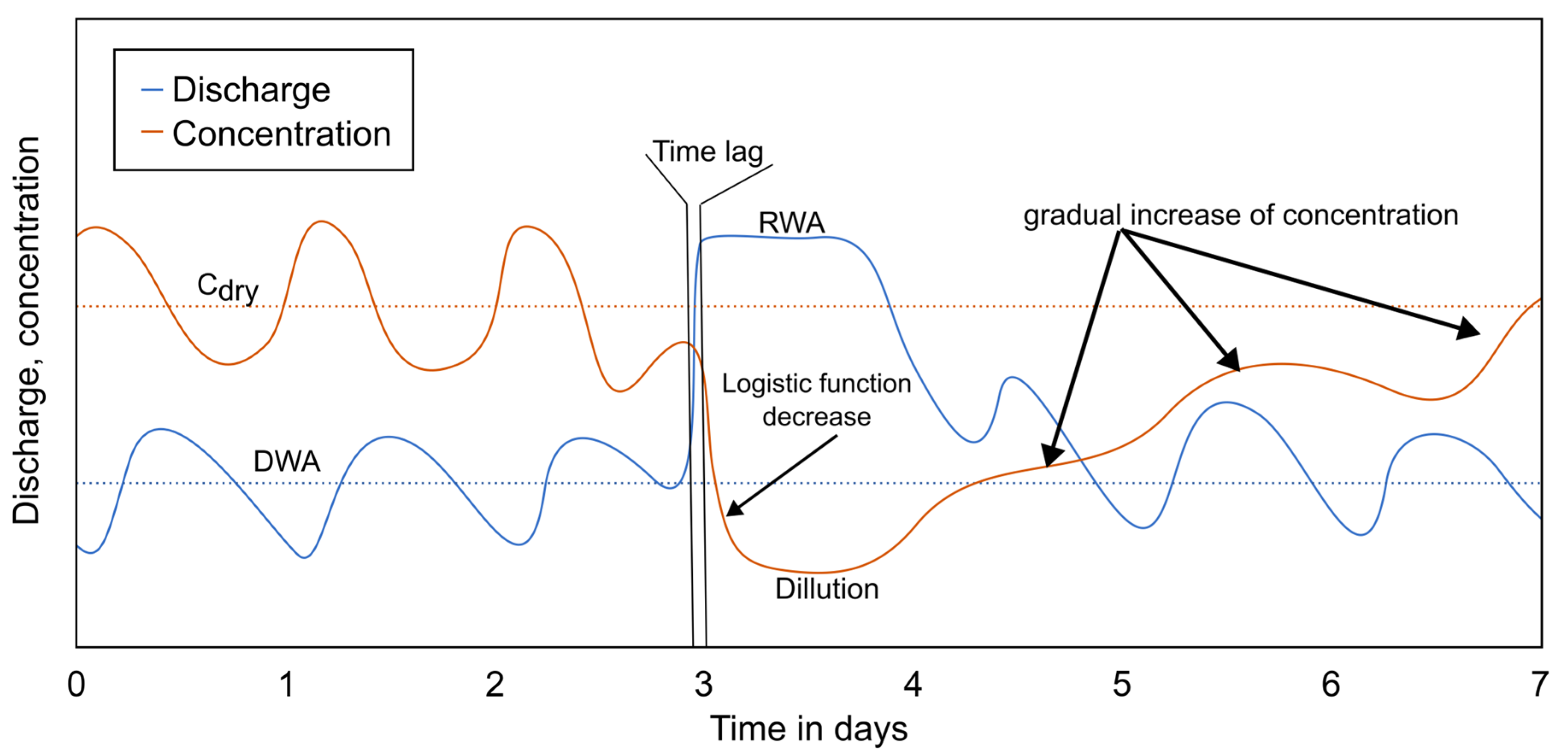
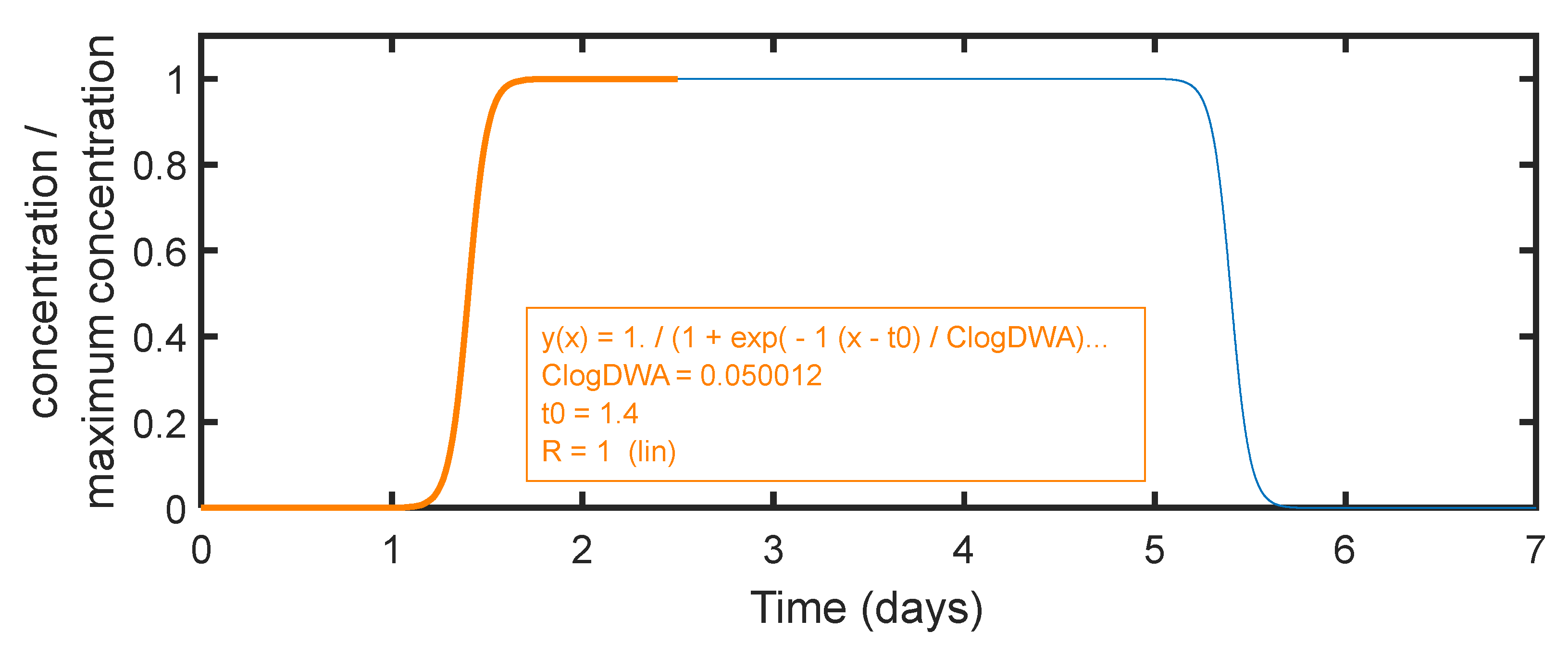
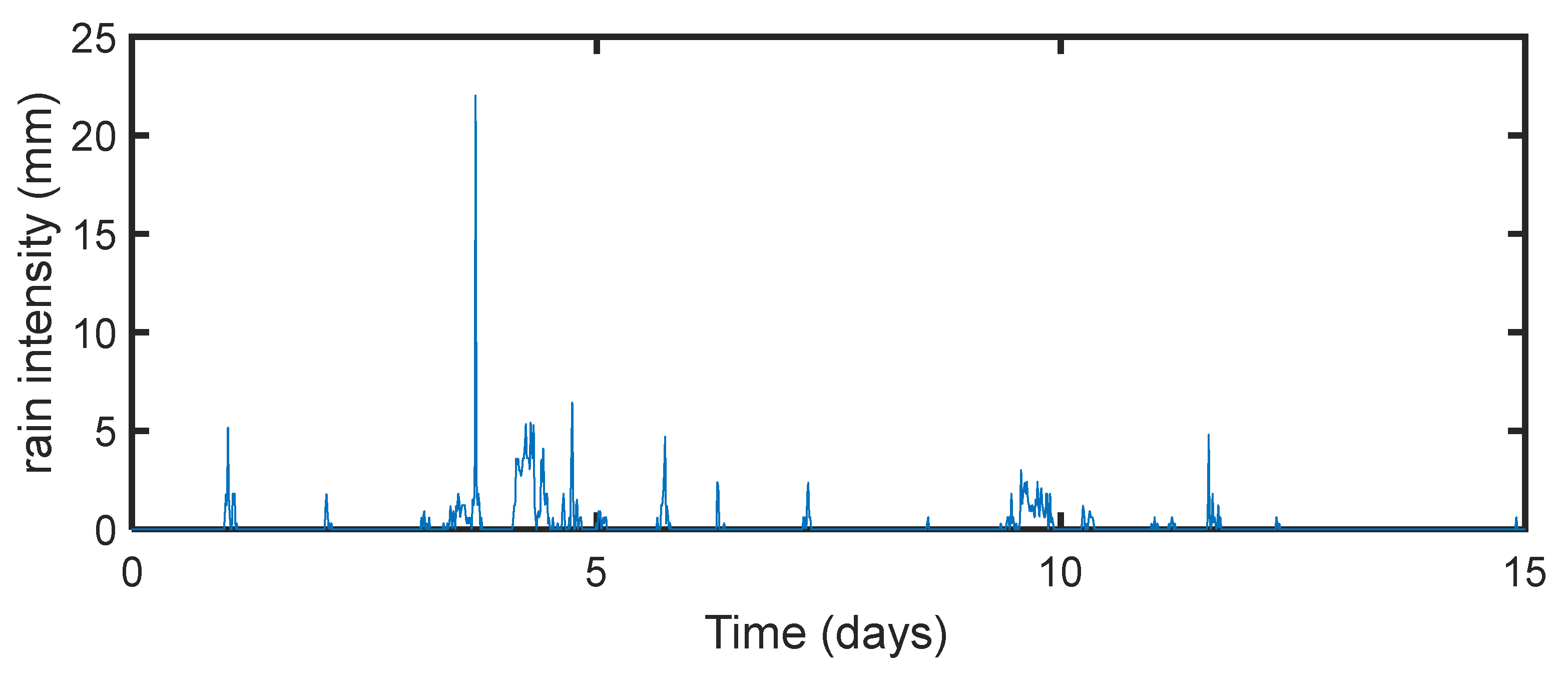
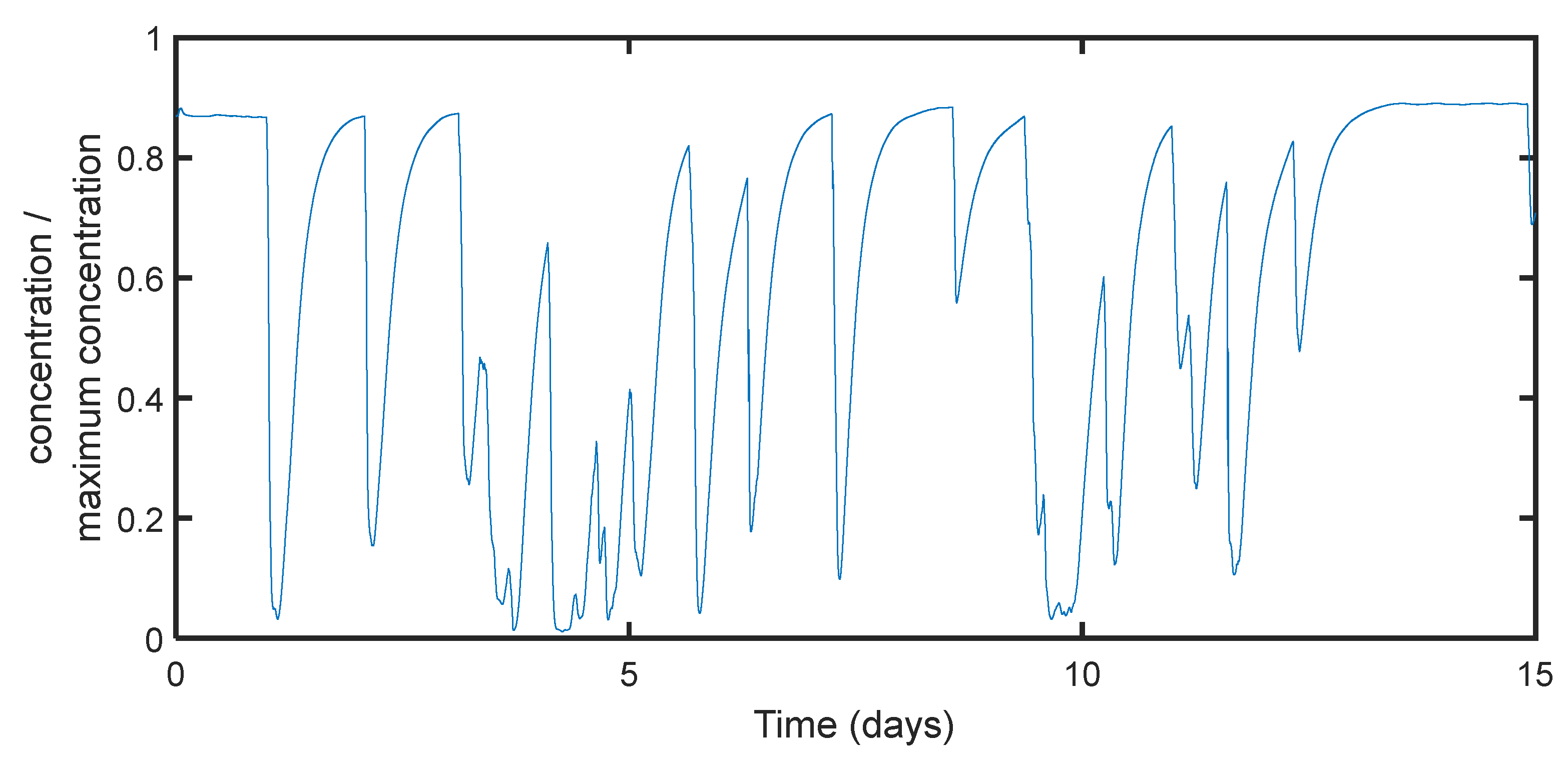
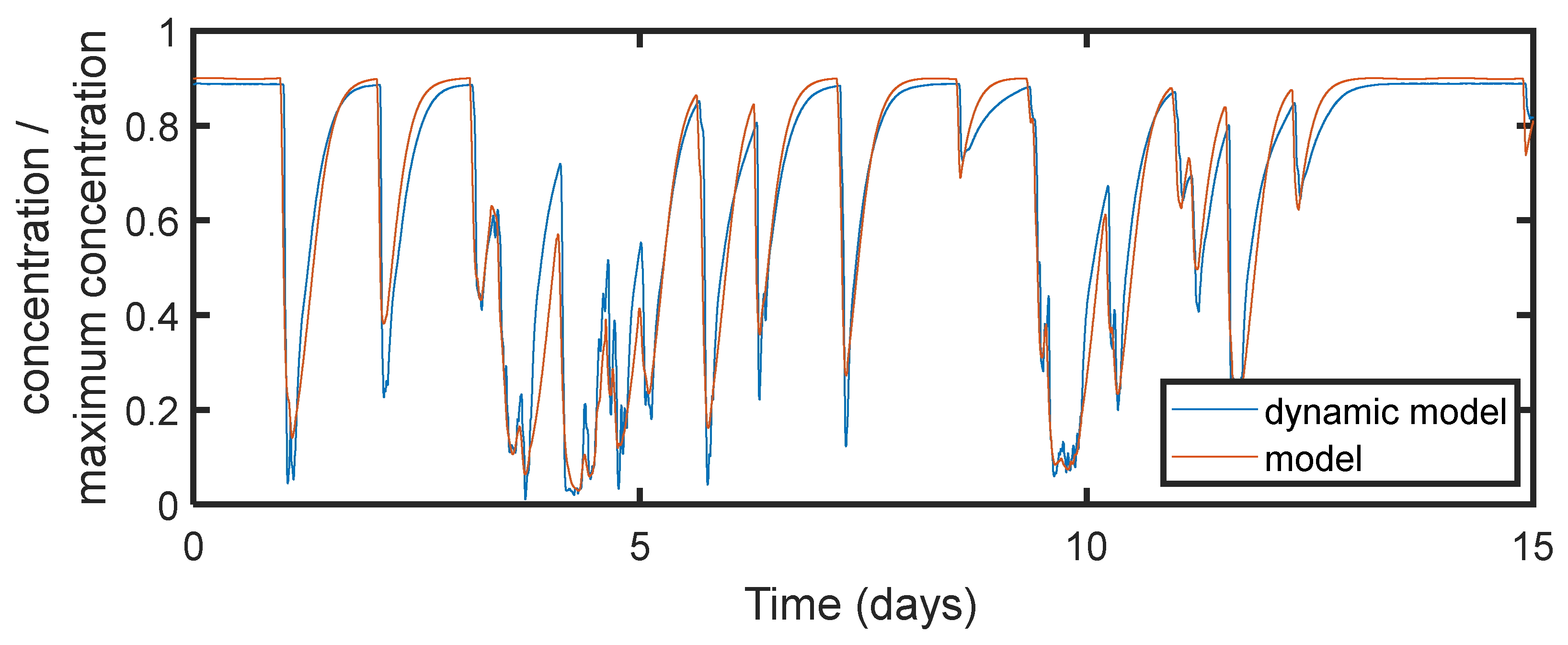
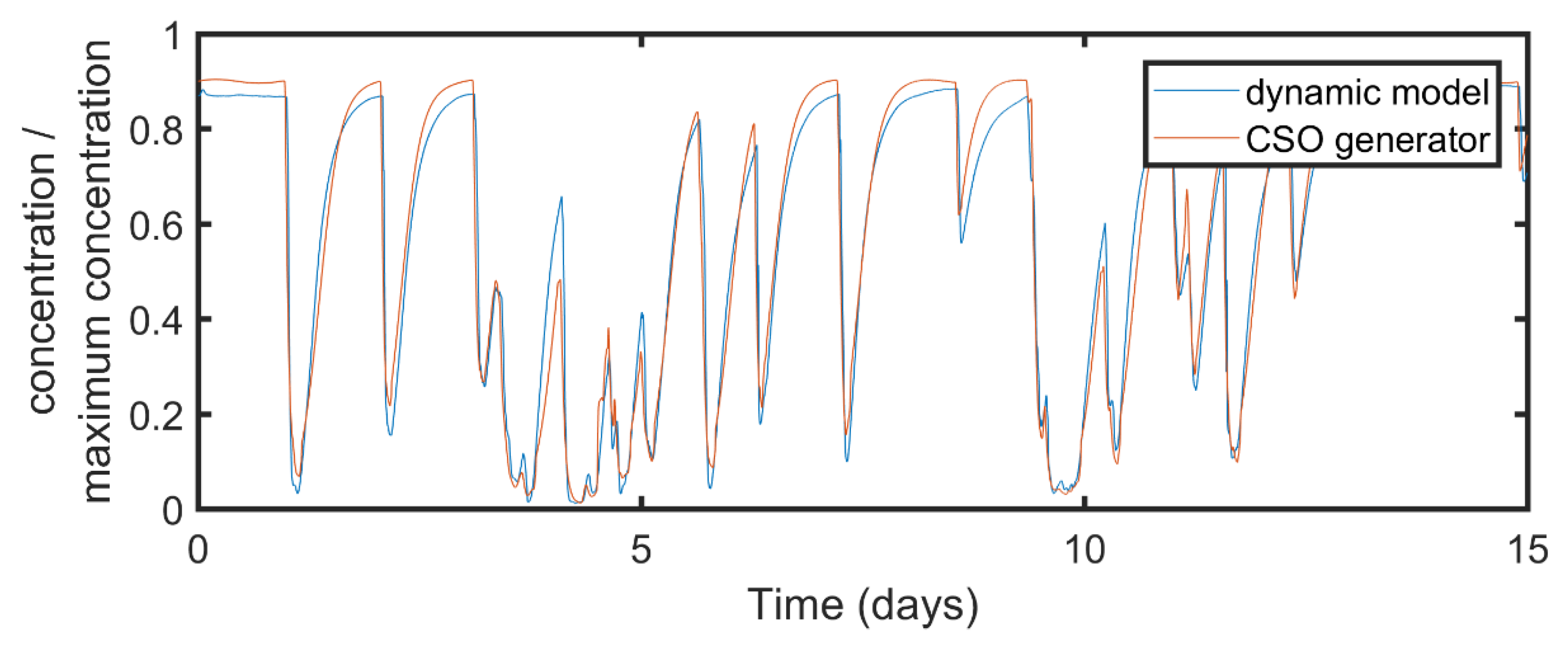
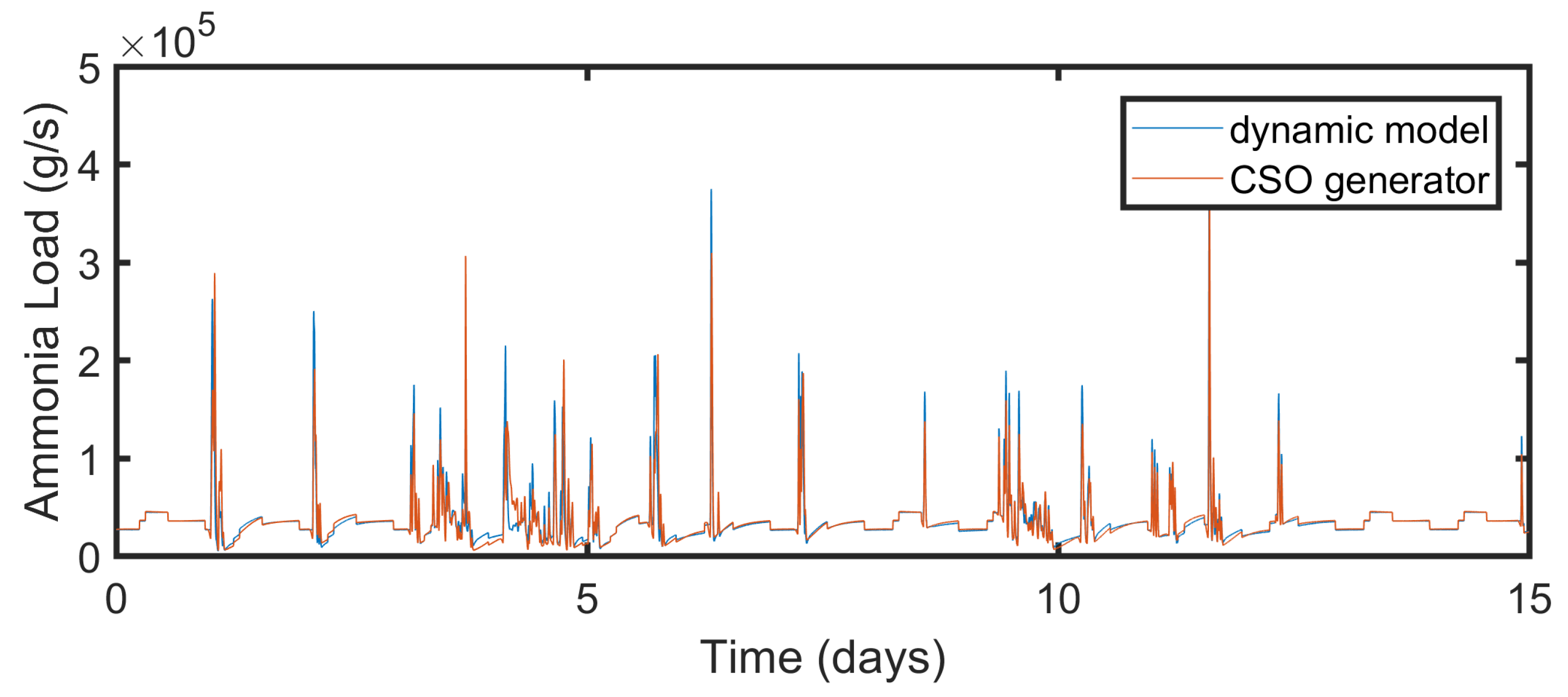


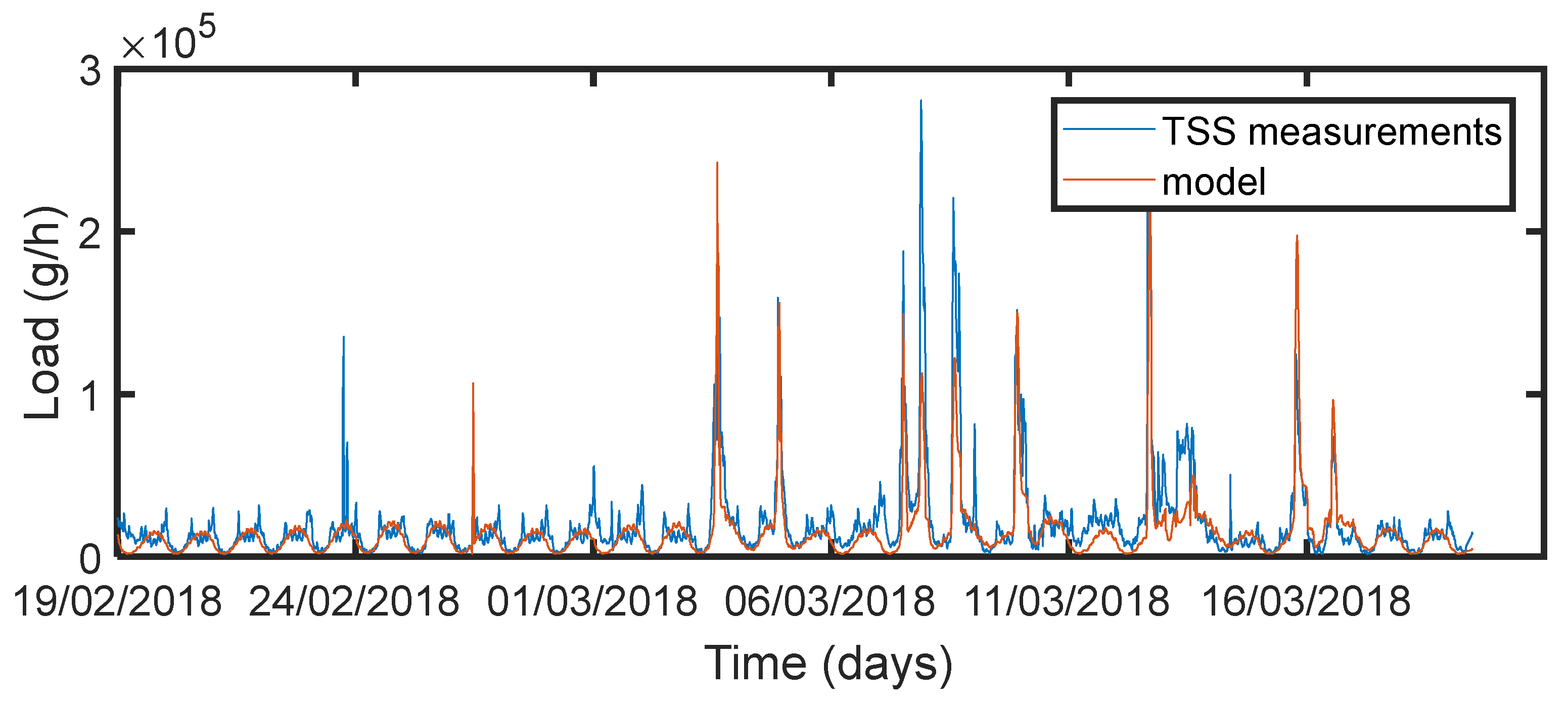
Disclaimer/Publisher’s Note: The statements, opinions and data contained in all publications are solely those of the individual author(s) and contributor(s) and not of MDPI and/or the editor(s). MDPI and/or the editor(s) disclaim responsibility for any injury to people or property resulting from any ideas, methods, instructions or products referred to in the content. |
© 2023 by the authors. Licensee MDPI, Basel, Switzerland. This article is an open access article distributed under the terms and conditions of the Creative Commons Attribution (CC BY) license (https://creativecommons.org/licenses/by/4.0/).
Share and Cite
Wambecq, T.; Kroll, S.; Van Assel, J.; Delgado, R. CSO Generator—A Parsimonious Wastewater Quality Model for Combined Sewer Overflows. Water 2023, 15, 3424. https://doi.org/10.3390/w15193424
Wambecq T, Kroll S, Van Assel J, Delgado R. CSO Generator—A Parsimonious Wastewater Quality Model for Combined Sewer Overflows. Water. 2023; 15(19):3424. https://doi.org/10.3390/w15193424
Chicago/Turabian StyleWambecq, Tom, Stefan Kroll, Johan Van Assel, and Rosalia Delgado. 2023. "CSO Generator—A Parsimonious Wastewater Quality Model for Combined Sewer Overflows" Water 15, no. 19: 3424. https://doi.org/10.3390/w15193424
APA StyleWambecq, T., Kroll, S., Van Assel, J., & Delgado, R. (2023). CSO Generator—A Parsimonious Wastewater Quality Model for Combined Sewer Overflows. Water, 15(19), 3424. https://doi.org/10.3390/w15193424





